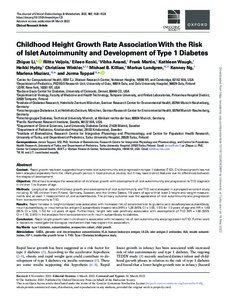Childhood Height Growth Rate Association With the Risk of Islet Autoimmunity and Development of Type 1 Diabetes
Li Zhiguo; Veijola Riitta; Koski Eileen; Anand Vibha; Martin Frank; Waugh Kathleen; Hyöty Heikki; Winkler Christiane; Killian Michael B.; Lundgren Markus; Ng Kenney; Maziarz Marlena; Toppari Jorma
https://urn.fi/URN:NBN:fi-fe2022081154317
Tiivistelmä
Context
Rapid growth has been suggested to promote islet autoimmunity and progression to type 1 diabetes (T1D). Childhood growth has not been analyzed separately from the infant growth period in most previous studies, but it may have distinct features due to differences between the stages of development.
Objective
We aimed to analyze the association of childhood growth with development of islet autoimmunity and progression to T1D diagnosis in children 1 to 8 years of age.
Methods
Longitudinal data of childhood growth and development of islet autoimmunity and T1D were analyzed in a prospective cohort study including 10 145 children from Finland, Germany, Sweden, and the United States, 1-8 years of age with at least 3 height and weight measurements and at least 1 measurement of islet autoantibodies. The primary outcome was the appearance of islet autoimmunity and progression from islet autoimmunity to T1D.
Results
Rapid increase in height (cm/year) was associated with increased risk of seroconversion to glutamic acid decarboxylase autoantibody, insulin autoantibody, or insulinoma-like antigen-2 autoantibody (hazard ratio [HR] = 1.26 [95% CI = 1.05, 1.51] for 1-3 years of age and HR = 1.48 [95% CI = 1.28, 1.73] for >3 years of age). Furthermore, height rate was positively associated with development of T1D (HR = 1.80 [95% CI = 1.15, 2.81]) in the analyses from seroconversion with insulin autoantibody to diabetes.
Conclusion
Rapid height growth rate in childhood is associated with increased risk of islet autoimmunity and progression to T1D. Further work is needed to investigate the biological mechanism that may explain this association.
Kokoelmat
- Rinnakkaistallenteet [27094]
